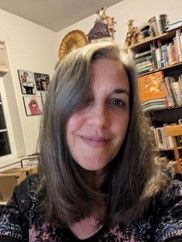Selective Mutism, Fairy Tale Curse, and Spotlight
Join me today as author Lisa Pelissier shares about her latest release and an almost-invisible disability.
About Lisa:
Lisa Pelissier lives in Oregon where she is a homeschool mother of four and self-published author of five middle-grade fiction novels, as well as two early-readers' chapter books and a YA fantasy novel. Lisa owns SneakerBlossom Books, offering Christian, classical homeschool study guides and curriculum. She also works as a freelance copy editor, copy writer, and virtual assistant. She blogs at Eleventh Willow (at the SneakerBlossom website), a site she and two friends started for Christians parenting the mentally ill. In her spare time Lisa enjoys making art, playing the piano, and singing.
Connecting Online:
Website:
https://www.sneakerblossom.com/
Email: sneakerblossom (at) yahoo.com
Blog:
https://www.sneakerblossom.com/eleventhwillow
Facebook:
https://www.facebook.com/lisa.pelissier.author
Instagram:
https://www.instagram.com/lisaedkela/
Pinterest:
https://www.pinterest.com/edkela/
Amazon:
https://www.amazon.com/stores/Lisa-Pelissier/author/B08794GCR1
YouTube:
https://www.youtube.com/@SneakerBlossom
TikTok:
https://www.tiktok.com/@lisapelissier1
I have a new book coming out today. It has been a work in progress for the past four years, off and on. I struggled to write this one.
The message, I felt, wasn’t saying what I wanted it to say. The characters were too quirky, too messy, and too disobedient to what I, the author, wanted them to do. I kept at it because this book was my daughter’s idea.
She told me to write a book about a girl with selective mutism—like herself. Only the girl’s disability wasn’t part of who she was. The girl in the book wouldn’t be able to speak, not because of selective mutism, but because a fairy curse took her voice away.
I should backtrack a little here to explain what selective mutism is. Selective mutism is a form of OCD in which the person is only able to talk to particular people and/or in particular places. My daughter, like Stasia in the book, lost her voice when she was three.
She could talk to immediate family and about five other people, but that was it. Don’t let the word “selective” mislead you—my daughter had no choice about which people were on the list of people she could talk to. It just happened. A glitch inside her somewhere made that selection.
In my new book, Speechless, the main character, twelve-year-old Stasia, can only talk to her best friend, sixteen-year-old Andie, who has non-verbal autism. When an old woman approaches Stasia and reveals that what she has is not a disability, but an evil magical curse, Stasia is shocked. With the help of Andie, Stasia must figure out the answers to the fairy’s riddles and perform quite a few bizarre tasks in order to reclaim her voice.
The problem I had was that I didn’t want my book to give the message that a disability is something to be overcome. A disability is not an enemy. For the most part, disabilities are in a person’s life to stay. The message I wanted to send should say that no one has to be perfect to do good things, to be brave, to be strong, or to be the hero of the story. The disability, ideally, would be a side note, not the focus of the book.
I think I managed to stay true to my core beliefs, while at the same time, giving flesh and bones to my daughter’s vision for the story. Having non-verbal, autistic, really messy Andie rescues the story from being a trite and false dream of overcoming adversity. Andie is broken in ways that can’t be fixed—like most of us, whether or not we have a physical, neurological, or mental disability. Andie is a true friend, a good friend, a major actor in the story—all while being exactly who she is.
I hope this story will inspire kids to look beyond people’s differences and find friendship where maybe they wouldn’t have looked before.

